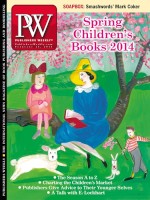Strong children’s departments and specialty stores are built book by book, category by category. But other factors can come into play when kids, parents, and teachers are deciding where to shop. Here are some simple but effective changes that booksellers have made over the past year to make their children’s areas stand out. They range from improving sightlines and displays so that customers can find the books they want more easily to creating community with book clubs.
Opening a Store Within a Store
Brookline Booksmith (Brookline, Mass.)
In fall 2012, Brookline Booksmith tested its first store-within-a-store after buying the assets of a local travel bookstore that closed, in effect creating a travel bookstore boutique. In the intervening year and a half, the store has begun making over a number of sections, including its “Kidsmith” children’s area in the back of the store. “Sometimes I say we have seven stores under one roof, if you include events,” says manager/co-owner Dana Brigham.
Marking off the section visually with decorative lights and yellow and green signage has helped boost sales in the children’s section, which takes up 10% of the store’s selling space and accounts for 19% of sales. “Every week, children’s ranges from between one third and one half of the number of units we’re re-ordering,” adds assistant manager and buyer Lisa Gozashti, who notes that it’s time for an expansion. “Over the next month we’re moving sightlines so you’ll see your way more clearly back into the space.”
The store has already moved some shelving to improve visibility for the distinctive handmade tree, created by a local artist, and to make more space for activity-related books. Later this spring it plans to add a second table for kids’ sale books. “[The kids’] section is just packed. It is like a garden,” says Gozashti. “The tree sets the space, and it gets fuller.”
Making New Picture Books Stand Out
Devaney Doak & Garrett Brooksellers (Farmington, Maine)
There’s no mistaking that DDG Booksellers carries a strong selection of children’s titles; it has a blended display area with both adult and kids’ books up front. But late last year, owner Kenny Brechner decided to kick it up a notch and repurposed a spinner rack to display the store’s newest picture books adjacent to new hardcovers for adults. “No matter how much I love a new picture book, it has to prove itself. If it can’t sell off the spinner, it doesn’t become a part of the regular inventory,” he says. “It helps us keep up the quality of the kids’ section.”
Brechner has found that the spinner rack provides additional advantages. It offers an economical way to display all new picture books faced out, and an easy way for staffers to find the newest picture books. Also, when parents and teachers who shop the store regularly come in, they can immediately see what’s new.
Adding a "Great Teen Room"
Blue Marble Books (Ft. Thomas Ky.)
Thirty-five-year-old Blue Marble is located in a house that is shared by owners Peter and Tina Moore. It has long had a Great Green Room just like the one in Goodnight Moon. Two years ago it removed “children’s bookstore” from its name. Then last fall the store created a Great Teen Room with books for ages 13–19 by repurposing a room that had held posters and sale books. The store held a grand opening with four local rising stars of YA fiction—Liz Coley, Melissa Landers, Carey Corp, and Jennifer McGowan—and is making plans for more events and a teen panel, or group.
“The explosion in popularity of YA literature is justification for a separate teen room, and as we all know, teens seem to really enjoy having their own space, so this is an answer to all of that,” said Peter Moore, who manages the store. “Our teen room added about 25 sq. ft. to our teen space. YA had been scattered over several parts of the store. But more importantly it added more face-out shelving and a space for just teens and their YA books. There hasn’t been a bump in traffic and sales since [the grand opening]. But the weather has been brutal for all our business in January and February. I’m optimistic about this spring, whenever it gets here.”
Clubbing
Cellar Door Books (Riverside, Calif.)
Long before Linda Sherman-Nurick opened Cellar Door in October 2012, she had helped start a book club for her then third-grade son at Imagine That!, a local children’s bookstore, since closed, and remembered how close it made both of them feel to the store. So when she opened her own general bookstore, she knew that book clubs would be an integral part of it. “Our kids’ book clubs are enormously successful,” says Sherman-Nurick. “We might have only 10 to 12 kids attend. But when the kids are here, their parents and siblings come to the store. We put all of our book club books on the front table with a list of our clubs. Those are, without fail, our bestsellers. We have 14 clubs, and a lot of people buy and read the books.”
Currently, there are four book clubs for kids—“mini readers,” children’s, middle grade, and YA. “Because of the book clubs, parents are really loyal to the store,” says Sherman-Nurick, who had one parent volunteer to do storytimes. The children are equally loyal, and when a group of parents asked Sherman-Nurick about adding a fifth book club for early readers, one of the kids in another club agreed to run it.



 Volume 261
Issue 08
02/24/2014
Volume 261
Issue 08
02/24/2014





